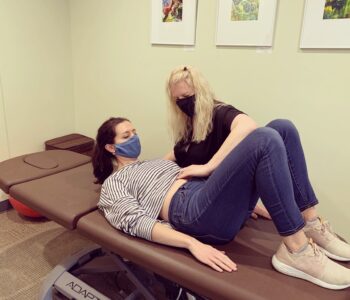 Postpartum Physical Therapy
Postpartum Physical Therapy
Postpartum and Diastasis Recti Abdominis (DRA)
Diastasis Recti Abdominis…DRA. What is it this term so loosely thrown around in the postpartum period? Why is it SO important? My doctor diagnosed me with this, what does it mean for ME? Let’s get some clarity, people!
Diastasis Recti Abdominis (DRA) is defined as separation of the outermost abdominal muscle layer. The right and left rectus muscles are joined by the linea alba, a line of connective tissue. This line provides structure and stability to the abdominal muscles and the trunk. DRA occurs when there is an abnormal separation of the rectus muscles, resulting in a greater width or stretch of that line. To us, it can look like either a doming bulge or concavity in the center of the belly when completing a curl up or crunch.
It is very common to have some degree of DRA after birth, but this separation should return to a more normal width within a few weeks. If a large separation persists, it can be associated with low back pain and pelvic floor dysfunction. What is a normal width of separation? Anything less than 3.0 cm at the umbilicus (belly button) is considered within normal limits when measuring for DRA. How do we measure it? The easiest way to check for DRA is by using the finger width method. However, know that this method, while quick and simple, is not the most reliable…think about how many different sized fingers there are out there! Nonetheless, it can be a great screening tool to identify significant separation of the abdominal wall. So, lying on your back with knees bent and trunk relaxed, curl up so that your shoulders are off the floor. Place your fingers horizontally at your belly button, and see how many fingers fit into your belly button cavity….one, two, three, four? This should give you a general idea of width (3 cm is about 2 finger widths).
Crap, I’m at 3.5 finger widths! Am I doomed? The answer is NO! There are many ways that physical therapy can help with DRA. Also, more importantly, it’s not the separation that matters, it’s how you use it. Studies show that if you can engage your deepest abdominal layer with a curl up, despite having a wider than normal separation, this stiffness can provide beneficial stability and support to the trunk with activity. The key is learning how to control this deepest abdominal layer, the Transversus Abdominis, as well as the pelvic floor muscles, to create that stability. This work can also help to reduce a DRA. Breathing and pelvic tilting are some of the early exercises to help reduction in separation. Planks and quadruped are some of the more advanced progressions.
Bottom line: DRA is common in the postpartum period. Often times, this separation will resolve on it’s own. If you are noticing that you have a larger separation or that this is accompanying low back, sacroiliac, or pelvic pain, reach out to your PTs! We can help more accurately assess the DRA and get you on track with reducing that gap!
Written by Kerry DeGaetani, PT, DPT, SCS. Kerry has a Certificate of Achievement in Obstetrics Physical Therapy and is the proud mama of two spirited kiddos, ages 3 and 1 ? Information adapted from Fundamental Topics of Pregnancy and Postpartum Physical Therapy, Section on Women’s Health, APTA.